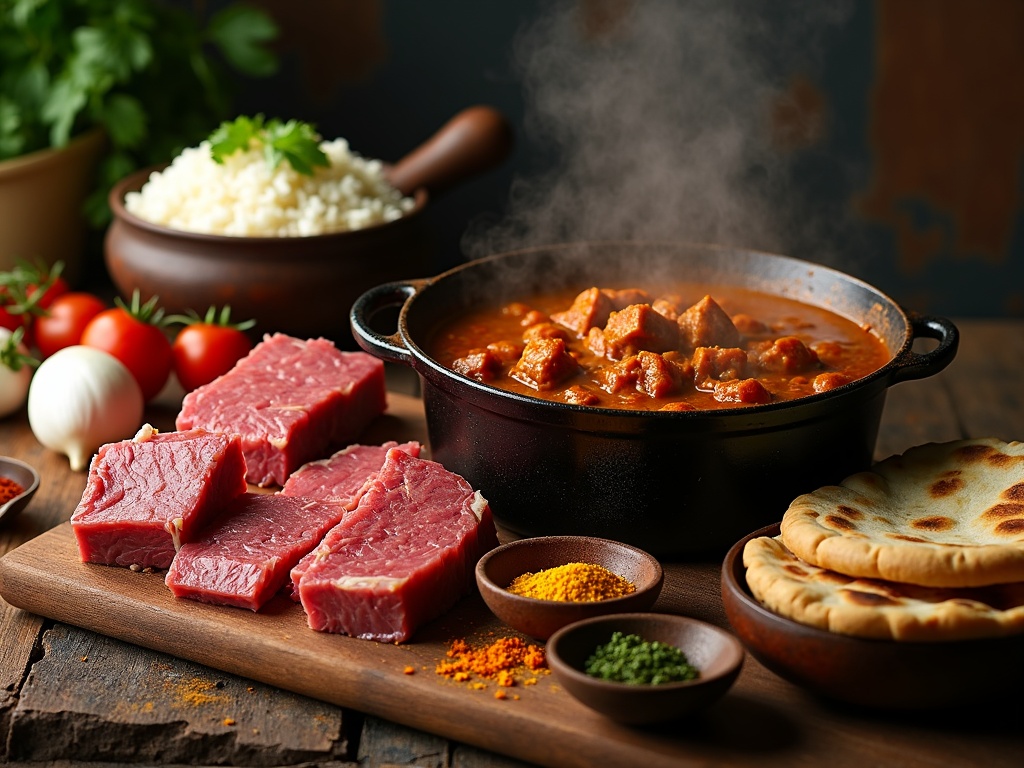Beef curry delivers bold flavors and fork-tender meat through slow-cooking that infuses spices deeply into the dish. The transformation happens when quality beef meets the right spice blend and proper cooking methods, turning basic ingredients into a meal that tastes just as good as restaurant versions.
Find In This Article
Key Takeaways
- Choose marbled cuts like chuck roast or brisket for the most tender beef curry, cutting them into uniform 1-inch cubes for even cooking.
- Slow cooking (1.5-2 hours stovetop, 45 minutes in pressure cooker, or 6-8 hours in slow cooker) is essential for developing deep flavors and breaking down tough muscle fibers.
- Properly bloom spices in oil before adding liquids to release their full aromatic potential and create the foundation for authentic curry flavor.
- Regional variations exist worldwide, from coconut-based Thai curries to complex Indian versions, each with unique ingredient profiles.
- Beef curry provides excellent nutrition with approximately 20% protein content and significant amounts of vitamin B12, iron, and zinc.
I’ve found that the perfect beef curry balances richness, spice complexity, and meat tenderness. The dish offers incredible flexibility across cooking methods while maintaining its signature depth. What makes curry special is how it transforms over time – flavors meld and intensify, making leftovers even better than the first serving.
The Ultimate Guide to Making Authentic Beef Curry at Home
Creating a delicious beef curry at home doesn’t have to be complicated. I’ve spent years perfecting my technique and found that patience is key to developing those deep, complex flavors that make curry so irresistible. Let me share my best tips for transforming simple ingredients into a curry that rivals your favorite restaurant.
Selecting the Perfect Cut of Beef
The foundation of any great beef curry dish starts with choosing the right cut. For curries, tougher cuts with good marbling actually work best because they break down beautifully during cooking:
- Chuck roast: My personal favorite, this cut has excellent marbling and becomes fork-tender when slow-cooked.
- Brisket: Slightly fattier but adds incredible richness to your curry.
- Flank: Leaner option that still offers good flavor when properly cooked.
- Stewing beef: Pre-cut option that works well in a pinch.
These cuts have connective tissue that melts during cooking, creating that melt-in-your-mouth texture you’re looking for. I always trim excess fat but leave some for flavor, cutting the meat into 1-inch cubes for even cooking.
Mastering the Cooking Process
The secret to an authentic beef curry recipe lies in the cooking method. Slow-cooking isn’t just an option—it’s essential for developing those complex flavors and achieving tender meat.
For stovetop cooking, I start by browning the meat in batches (never overcrowd the pan!), then sautéing onions, garlic, and ginger in the same pot to capture all those flavorful bits. After adding spices and allowing them to bloom for 30 seconds, I return the beef to the pot with liquid and simmer covered for 1.5-2 hours, checking occasionally to stir and add liquid if needed.
Using a pressure cooker cuts time dramatically—just 45 minutes under pressure creates tender beef. For slow cookers, I set it on low for 6-8 hours or high for 3-4 hours. The longer cooking methods develop deeper flavors, but all approaches yield delicious results.
The timing really depends on your chosen method:
- Stovetop: 1.5-2 hours of gentle simmering.
- Pressure cooker: 45 minutes at pressure with natural release.
- Slow cooker: 6-8 hours on low or 3-4 hours on high.
I always finish my beef dishes with a rest period. Letting the curry sit for 15-20 minutes after cooking allows flavors to meld together and creates that authentic taste profile.
For restaurant-quality results, I recommend these techniques:
- Toast whole spices before grinding for more aromatic results.
- Create a proper base by slowly caramelizing onions (20-30 minutes).
- Bloom your spices in oil to release their full potential.
- Add a splash of acid (lemon juice or vinegar) at the end to brighten flavors.
- Garnish with fresh herbs just before serving.
The transformative magic happens during that long, slow cook when the spices infuse the meat completely. What starts as separate ingredients becomes a unified, rich beef curry with layers of flavor.
This cooking method works beautifully for various curry styles—whether you’re making a rich Rogan Josh, aromatic Madras, or fiery Vindaloo. The fundamentals remain the same, while the spice blends change to create different regional variations.
For beginners, I suggest starting with a ground beef curry which cooks faster, then gradually working up to these longer-cooking versions using larger beef pieces. Once you master the basic technique, you’ll find endless possibilities for creating your own signature beef recipes with international flair.
A World Tour of Beef Curry Traditions
The global appeal of beef curry dishes extends across continents, with each region adding its own distinctive twist to this flavorful dish. The beef industry itself is massive, valued at $384 billion in 2021, showing just how central this meat is to cuisines worldwide.
Asian Curry Traditions
In Indian cuisine, beef curry (in regions where it’s consumed) features complex spice blends like garam masala, turmeric, and cumin. The preparation often involves slow-cooking the meat until tender, allowing it to absorb the rich tapestry of spices. I find that Indian beef curries typically have a thicker gravy and more intense flavor profile compared to other regional variations.
Thai beef curry takes a different approach, incorporating coconut milk as a base, creating a silky, slightly sweet curry sauce. The addition of lemongrass, galangal, and Thai basil gives these curries their signature aromatic quality. Thai red and green curries with beef and vegetables offer a beautiful balance of spicy, sweet, and savory notes that’s instantly recognizable.
Caribbean and Global Interpretations
Caribbean beef curry represents another fascinating tradition, heavily influenced by the region’s history and cultural exchanges. These curries often include potatoes and are seasoned with unique spice blends featuring scotch bonnet peppers for heat. The result is a hearty beef casserole with distinctive island flavors.
Beyond these regions, beef curry has been adapted worldwide:
- Japanese curry features a thicker, sweeter sauce often served with rice or udon noodles.
- British curry house versions typically include minced beef recipes like keema curry.
- Malaysian beef rendang, while not strictly a curry, shares similar cooking techniques with intensely reduced coconut milk.
In South Asian cultures, serving beef curry (where culturally appropriate) symbolizes hospitality and generosity. The dish frequently appears at celebrations and festivals across many curry-loving nations. In Thailand, massaman beef curry might grace special occasions, while in Jamaica, curry goat and beef often feature at community gatherings.
What I find fascinating is how beef stew variants like curry transcend borders while maintaining cultural significance. Whether it’s the fiery vindaloo of Goa or the fragrant Panang curry of Thailand, beef curry’s global journey continues to evolve while honoring traditions dating back generations.
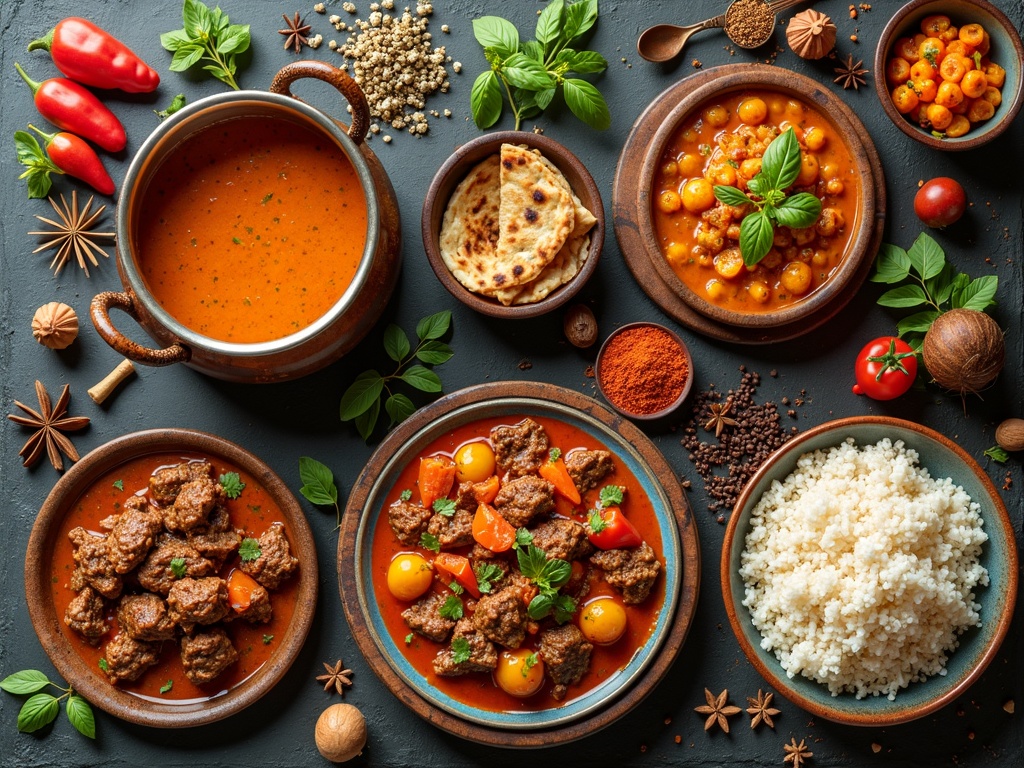
Essential Ingredients for the Perfect Curry
Creating a flavorful beef curry starts with gathering high-quality ingredients. I’ve found that using fresh components makes a noticeable difference in the final dish’s taste and aroma.
Core Components
The foundation of any excellent authentic beef gosht curry begins with these essential ingredients:
- Beef: Choose cuts with some marbling like chuck or brisket for tender results
- Onions: Forms the base of most curry gravies, providing sweetness when caramelized
- Garlic and ginger: Fresh is preferable as they provide aromatic depth
- Tomatoes: Either fresh or canned, they add acidity and body to the sauce
These basics create the canvas for your spices to shine. I’ve discovered that properly sautéing onions until golden brown before adding garlic and ginger can transform your curry’s depth of flavor.
Spice Selection and Technique
The magic of a beef casserole curry happens through its spice blend. These key spices create that distinctive curry flavor:
Cumin and coriander provide earthy notes, while turmeric adds color and subtle bitterness. Garam masala, a blend itself, contributes complex warmth, and chili powder controls the heat level. I can substitute kashmiri chili for regular chili powder when I want color without excessive heat.
For those with dietary restrictions, coconut milk can replace dairy, and tamari works instead of soy sauce for gluten-free options. If cooking for someone with nightshade sensitivities, I’ll use pumpkin or sweet potato puree instead of tomatoes.
Regional variations showcase fascinating differences. Northern Indian curries often feature cardamom, cloves, and cinnamon. Southern Indian versions incorporate mustard seeds and curry leaves. Meanwhile, beef and vegetable curries from Thailand typically include lemongrass and galangal.
The timing of adding spices is crucial for developing flavor. I always start by blooming whole spices in hot oil, followed by ground spices, being careful not to burn them. This technique, called tempering, releases the spices’ essential oils. Adding robust spices early allows them to permeate the meat, while delicate herbs and finishing spices go in toward the end.
For a minced beef curry, the process remains similar, though cooking times are reduced. Whether creating a fusion beef dish or a hearty beef stew with curry influences, these ingredient principles remain consistent.
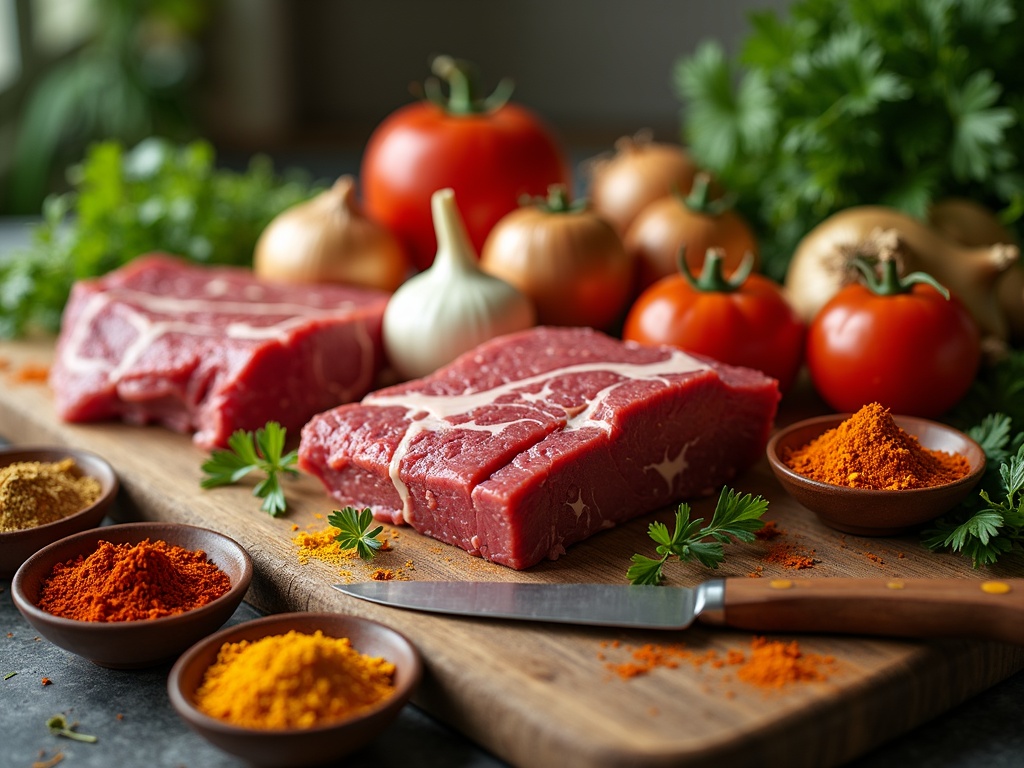
Power-Packed Nutrition in Every Bowl
I often tell people that a good beef curry dish isn’t just a feast for your taste buds—it’s also packed with impressive nutritional benefits. Each steaming bowl delivers a balanced combination of macronutrients and essential vitamins that can support your overall health in numerous ways.
Macronutrient Profile
A typical 150g serving of beef curry contains between 300-400 calories, making it a reasonable meal option that won’t break your caloric bank. What makes this dish truly stand out is its protein content—approximately 20% of its composition is pure, high-quality protein. This makes beef curry an excellent choice for anyone looking to meet their daily protein requirements.
The fat content ranges between 15-25%, which provides satiety and helps your body absorb the fat-soluble vitamins present in the dish. Don’t shy away from this fat content—it’s part of what makes beef goulash and curry dishes so satisfying and helps you feel full longer after eating.
Micronutrient Powerhouse
One of the most impressive aspects of beef curry is its vitamin and mineral content. A single serving provides approximately 70% of your daily value of vitamin B12—a nutrient essential for nerve function and the production of DNA and red blood cells.
The dish is also a rich source of iron, which helps transport oxygen throughout your body and prevents fatigue. If you’ve been feeling tired lately, adding some beef dishes like teriyaki or curry to your diet might give you the energy boost you need.
Zinc is another mineral found abundantly in beef curry. This essential micronutrient supports immune function and wound healing, making it particularly valuable during cold and flu season or when recovering from injury.
Functional Benefits
The nutritional profile of beef curry translates into several practical health benefits:
- Muscle Support: The high protein content makes it ideal for muscle maintenance and growth, especially important for those who exercise regularly.
- Energy Production: The B vitamins, particularly B12, play a crucial role in converting food into energy your body can use.
- Blood Health: The iron content helps maintain healthy red blood cells and prevents anemia.
- Immune Function: Zinc and other nutrients support your body’s natural defense systems.
- Cognitive Function: B12 is essential for brain health and neurological function.
For those looking to maximize their nutritional intake, I recommend pairing your beef and broccoli curry with whole grain rice or naan bread. This combination creates a complete protein profile while adding fiber to your meal.
Athletes and those with active lifestyles will particularly benefit from the high-quality protein and iron content. After a tough workout, a serving of beef curry can help replenish energy stores and provide the building blocks needed for muscle repair.
Older adults should note the high B12 content, as our ability to absorb this vital nutrient tends to decrease with age. Regular consumption of B12-rich foods like minced beef recipes including curry can help maintain adequate levels.
Parents might appreciate knowing that the zinc and iron in beef curry support healthy growth and development in children, while the protein helps build strong muscles during crucial developmental years.
I’ve found that incorporating beef casserole and curry dishes into my meal rotation once or twice a week provides a tasty way to ensure I’m getting these important nutrients without having to rely on supplements.
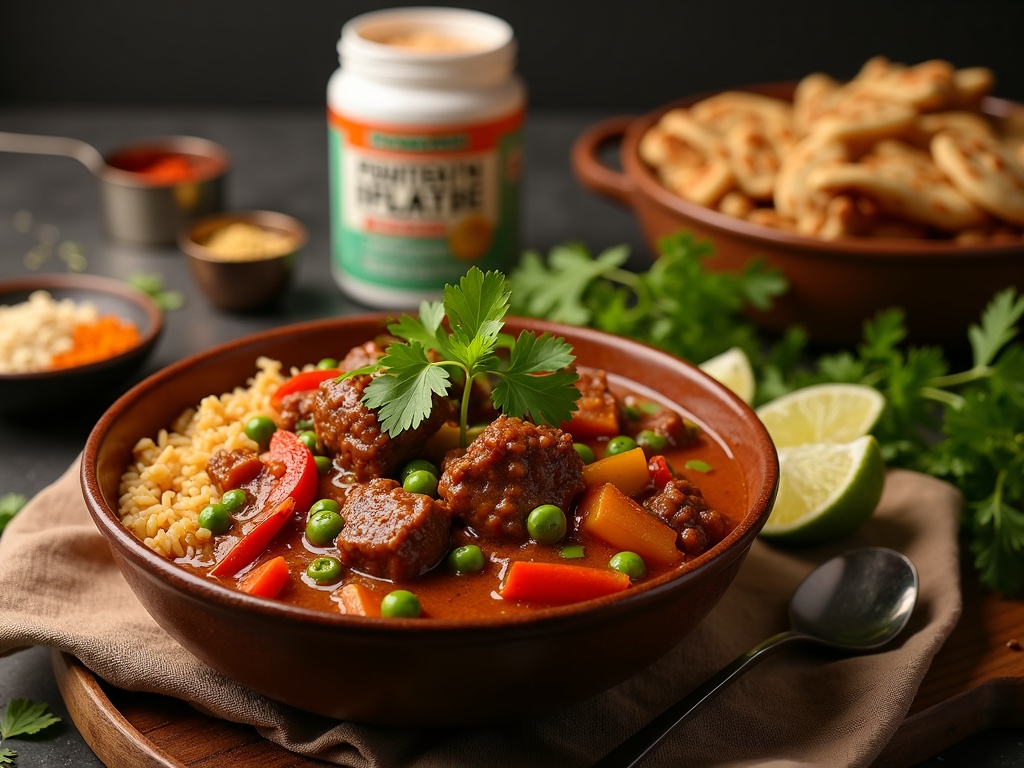
The Science Behind Great Curry
I’ve found that creating a truly exceptional beef curry dish involves understanding the scientific principles that transform simple ingredients into complex flavors. Cooking isn’t just an art—it’s chemistry in action, especially when it comes to developing deep, rich curry flavors.
The Magic of Slow Cooking
Slow cooking works wonders with beef curry by breaking down tough muscle fibers through a process called collagen denaturation. When I cook beef at low temperatures (around 160-180°F) for extended periods, the collagen in the meat transforms into gelatin, creating that melt-in-your-mouth texture everyone loves.
This slow process also allows fat to render gradually, distributing flavor throughout the dish while the spices have time to bloom and release their essential oils. I’ve discovered that this extended cooking time enables the Maillard reaction—a chemical interaction between amino acids and reducing sugars—creating hundreds of new flavor compounds that simply don’t develop during quick cooking.
The cooking method I choose dramatically affects the final texture of my beef casserole dishes and curries. Here are the main approaches and their effects:
- Pressure cooking: Creates tender beef in a fraction of the time by raising the boiling point of water, forcing moisture into the meat fibers
- Braising: My preferred method for curry—first searing to create flavor compounds, then slow-cooking in liquid to tenderize
- Sous vide: Precise temperature control ensures perfectly cooked beef that’s tender yet still medium-rare if desired
- Traditional stovetop simmering: Requires more attention but allows for easy adjusting of liquid levels and reducing sauce
Marinades play a crucial role beyond just adding flavor. When I prepare beef teriyaki or curry, I use acidic components like yogurt, citrus juice, or vinegar to begin breaking down proteins before cooking. Enzymes found in ingredients like papaya, pineapple, and ginger physically tenderize tough cuts by breaking down protein chains.
I’ve learned that fat-soluble spices like cumin, coriander, and turmeric need to be bloomed in oil before adding liquid ingredients. This process releases their full flavor potential, as many aromatic compounds aren’t water-soluble but dissolve beautifully in fat.
Temperature control makes all the difference between a good curry and a great one. I start with high heat (around 400°F) when searing beef for my beef goulash or curry to create those flavorful brown bits through the Maillard reaction. Then I drop to a bare simmer (around 180-200°F) for the slow-cooking phase.
This temperature shift prevents the meat from toughening and allows the sauce to gently reduce without scorching. Using a heavy-bottomed pot helps maintain stable temperatures and prevent hot spots that can burn delicate spices.
For perfect sauce consistency in my beef broccoli and curry dishes, I rely on several techniques. Natural thickeners like onions that break down during cooking help create body. Reduction through evaporation concentrates flavors and thickens without additives.
When I need additional thickening, I use one of these methods:
- Cornstarch slurry: Adds thickness without changing flavor, best added at the end
- Yogurt reduction: Adds creaminess while intensifying dairy notes
- Coconut cream: Perfect for Thai-style curries, adds richness and slight sweetness
- Nut pastes: Ground cashews or almonds add body and nutty flavor notes
- Minced beef recipes naturally release proteins that help thicken sauces
The finishing touch I always apply is balancing flavors with acid (lime juice or vinegar) to cut through richness, salt to enhance all flavors, and sometimes a touch of sweetness to round everything out. This scientific approach to curry-making transforms a simple dish into something truly extraordinary.
Serving and Pairing Your Curry
I’ve found that the right accompaniments can transform a good beef curry dish into an extraordinary meal. Traditional accompaniments vary significantly across regions, each adding their unique touch to enhance the curry experience.
Regional and Contemporary Pairings
In South Asia, beef curry is typically served with basmati rice, which absorbs the rich gravy perfectly. Indian variations often include naan bread, chapati, or paratha—all excellent for scooping up that delicious sauce. Pakistani traditions might feature roti or pulao rice with a side of raita (yogurt cucumber sauce) to cool the palate.
Southeast Asian curry traditions bring different pairings:
- Thai beef curries match beautifully with jasmine rice and a side of fresh herbs
- Malaysian and Indonesian versions often include coconut rice (nasi lemak)
- Japanese curry is commonly served with short-grain rice and pickled vegetables
Contemporary fusion pairings have expanded these options significantly. I’ve seen beef goulash recipes incorporating curry elements served with polenta, while fusion restaurants might pair beef teriyaki curry with quinoa or couscous. For something unexpected, try serving your curry with:
- Cauliflower rice for a low-carb alternative
- Crusty sourdough bread for a European twist
- Sweet potato mash for added nutritional value
For beverages, I recommend pairing beef curry with drinks that complement its spice profile. Mango lassi provides cooling relief from heat, while a light beer can refresh the palate between bites. Non-alcoholic options like cucumber-mint water or tamarind juice work wonderfully too.
Storage and Presentation
Beef curry actually improves with time as flavors meld together. Store it in airtight containers in the refrigerator for up to 3 days, or freeze portions for up to 3 months. When reheating, add a splash of water or stock to maintain moisture, and warm gently on the stovetop rather than microwaving to preserve texture.
Presentation varies by occasion. For casual family meals, serve beef and broccoli curry family-style in a large central bowl with sides in separate dishes. For entertaining, individual bowls with a small portion of rice, the curry, and garnishes arranged artfully can impress guests. Garnish options include:
- Fresh cilantro or mint leaves
- Thinly sliced red chilis for color and heat
- A swirl of coconut cream for contrast
- Crispy fried shallots for texture
For a contemporary touch with minced beef curry recipes, try serving in mini bread bowls or as part of a beef casserole fusion dish that combines multiple culinary traditions.
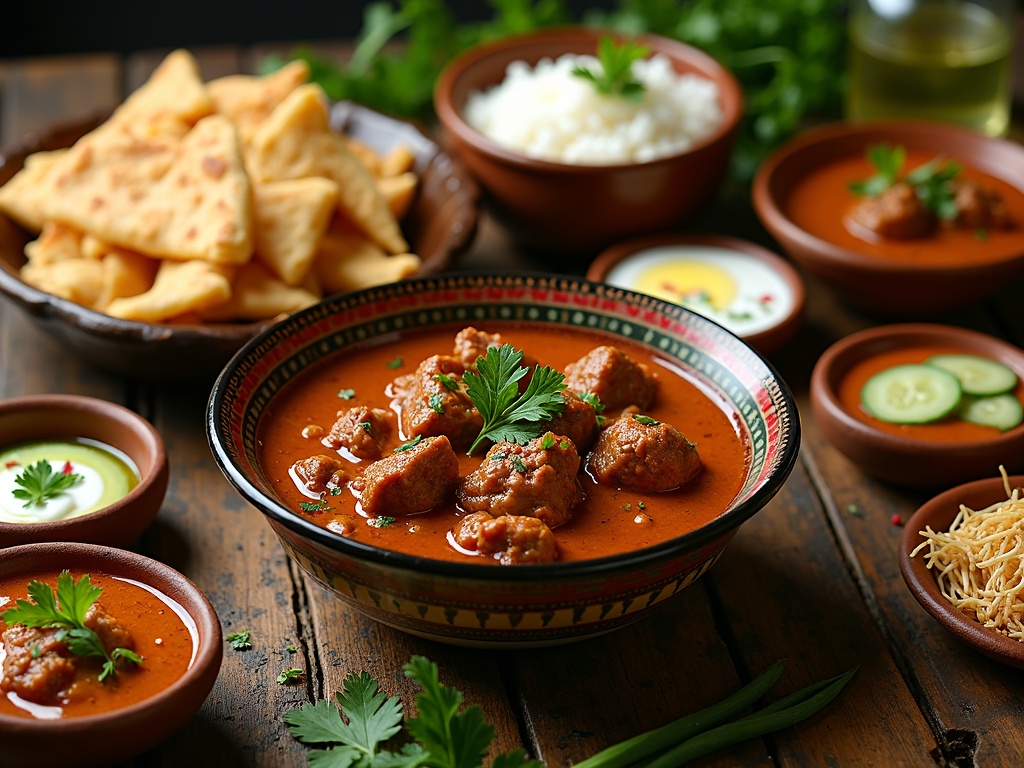
Sources:
Agriculture and Agri-Food Canada – Global Beef Market 2022
USDA FoodData Central – Beef Nutrition Facts
National Geographic – The Art of Curry 2021
Culinary Institute – Culinary Techniques Guide

